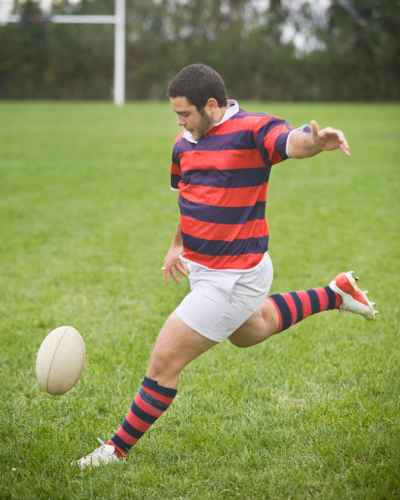Six types of kicks are used in rugby league to gain a tactical advantage, create scoring opportunities, or put pressure on the opposition.
This article looks at each one in turn. Some kicks are so important tactically that they deserve an article all to themselves. We’ll cover the essentials here and link out to where you’ll find all the details.
Short Dropouts Or Short Restarts
You may hear commentators refer to either the short dropout or a short goal-line dropout. This is when a team restarts play from their own goal line.
Either the ball has been grounded in their in-goal area or it has gone dead in-goal after being touched by a defender.
The team’s most accurate kicker (usually one of the halves or the fullback) kicks the ball at least ten metres forward. Usually the kicker sends the ball a long way downfield.
Going short is a tactical variation of the standard dropout. Because the defending team are standing deep expecting a long high ball, a short kick can catch them out.
The kickers teammates are ready to chase after the kick to try to regain possession. This is a big win for a team.
But there’s a risk to this. If the opposition grab the ball, they have better field position than if a standard dropout had been used.

Chip Kicks
Chip Kicks are short high kick that sends the ball over defenders but landing close enough for the kicker or teammate to rush forward and regather.
Think of a chip in golf. It’s a delicate maneuver that requires deft technique. A chip that is too low can land chest height into the arms of a grateful defender.
If it’s slightly too long, the kicker has given the ball to defenders who haven’t been pushed deep.
A chip kick is a short, lofted kick that goes over the defensive line and lands shortly behind it.
The kicker or a teammate rushes forward to run onto the ball and try to catch as it drops to the ground.
When To Use A Chip Kick
A well-organized defensive line can smother the attacking plays of their opposition.
When it seems like there’s no gap in the line, the chip kick offers something different. Instead of going through the line, the kicker sends the ball over it.
The best outcome is to catch the defenders off guard. By mixing up tactics and kicks, its more difficult for the opposition to predict the attacking play.
How Chip Kicks Are Executed
Kickers put their non-kicking slightly forward and pointing in the direction the ball should travel.
As the kicking foot moves forward, the player releases the ball.
The foot makes contact with the instep or the top of the boot. The strike is toward the bottom of the ball. This creates backspin and loft.
It’s important to follow through with the kicking foot. The follow through continues in the direction that the ball should travel. This helps aim and accuracy.
Because kickers are often also chasing the ball to catch it, there’s a risk that they don’t follow through on the kick in their haste to start running. That simply leads to an inaccurate kick.
It’s definitely a skill that needs a lot of practice. But players don’t need a lot of space. This is something they can do in a decent-sized back garden. You can’t say that about a cross-field kick.
Bombs And High Kicks

High kicks are angled to hang for as long as possible in the air to ives the the attacking team time to chase them.
You’ll hear commentators refer to “hang time” as they watch the trajectory of the ball. This is the amount of time the ball stays in the air after being kicked.
The high kick is often used to target the opposition fullback and wingers. The kicker’s teammates rush forward to put them under the pressure of making a difficult catch.
Check out our in-depth article on bombs and high kicks in league, which covers:
- How they are executed
- When they should be used
- What the kickers teammates do
- How the opposition defends them
Grubber Kicks
Grubbers are the opposite of high kicks. They are low to the ground and aimed so that they bounce predictably across the playing surface.
You’ll often seem them used when the attacking team are close to the try line but are on the last tackle.
Our in-depth article on grubber kicks in rugby league looks in detail at the tactics, attacking play, and how they are defended.
Cross-Field Kicks
Cross-field kicks travel more across the field than forward. The kicker usually wants to create a one-on-one contest between an attacking player and a defender.
It’s a common tactic when teams on the sixth play are in the opposition half. If the ball drops near to the try line, an attacking winger will try to catch it and get over for a try.
Read more in our in-depth article on cross-field kicks in rugby league. It goes into detail on technique and tactics.
40/20 Kicks
40/20 kicks are taken from behind the attacking team’s 40-metre line. The ball must travel far enough to bounce into touch within the opposition’s 20-meter area.
When these two conditions are met, possession of the ball goes back to the attacking team. The other big advantage is that the team has gained a lot of ground.
This tactical option has a lot more complexity in terms of attacking and defending than you might think.
You can read all about it in our in-depth article on 40/20 kicks in rugby league.